03-13-2023, 10:53 AM
Yesterday morning my friend, Scott, arrived with the hope we could catch and band the rare Harris’s Sparrow that continues to feed around the yard. We also wanted to band a White-winged Junco, a bird that breeds in South Dakota and winters here in small numbers.
The White-winged is the largest subspecies of Junco. The size difference can be hard to discern unless seen in close proximity to the other forms that winter here, including the Slate-colored, Oregon, Oregon pink-sided, and Gray-headed Junco. The Gray-headed is the only subspecies to remain and breed in CO.
The White-winged is lighter gray than the Slate-colored, it shows more white in the outer tail feathers in flight, and it’s distinguished by two white wing bars.


Both birds fed close to the traps but didn’t enter this time. We did band several Mountain and Black-capped Chickadees, and one of the Steller’s Jays. Also encountered was a Steller’s that we banded here in 2018.


While we were outside, the first American Dipper of the year appeared on the stream. Not one, but three individuals that sang and played territorial games around the dipper nest box by the cabin. There are a few open pools of water where the stream is otherwise covered with 2-3 feet of snow. At 6 a.m. this morning, a dipper was singing its bright song from the stream.
With so much snow this year, a heavy runoff could delay their nesting into late May or early June.
The White-winged is the largest subspecies of Junco. The size difference can be hard to discern unless seen in close proximity to the other forms that winter here, including the Slate-colored, Oregon, Oregon pink-sided, and Gray-headed Junco. The Gray-headed is the only subspecies to remain and breed in CO.
The White-winged is lighter gray than the Slate-colored, it shows more white in the outer tail feathers in flight, and it’s distinguished by two white wing bars.
Both birds fed close to the traps but didn’t enter this time. We did band several Mountain and Black-capped Chickadees, and one of the Steller’s Jays. Also encountered was a Steller’s that we banded here in 2018.
While we were outside, the first American Dipper of the year appeared on the stream. Not one, but three individuals that sang and played territorial games around the dipper nest box by the cabin. There are a few open pools of water where the stream is otherwise covered with 2-3 feet of snow. At 6 a.m. this morning, a dipper was singing its bright song from the stream.
With so much snow this year, a heavy runoff could delay their nesting into late May or early June.



